<< Our Photo Pages >> Garn Turne - Chambered Tomb in Wales in Pembrokeshire
Submitted by vicky on Thursday, 01 October 2020 Page Views: 15274
Neolithic and Bronze AgeSite Name: Garn Turne Alternative Name: Carn Turne, Garn TarneCountry: Wales County: Pembrokeshire Type: Chambered Tomb
Nearest Town: Fishguard Nearest Village: St Dogwells
Map Ref: SM97922725 Landranger Map Number: 157
Latitude: 51.907036N Longitude: 4.93915W
Condition:
| 5 | Perfect |
| 4 | Almost Perfect |
| 3 | Reasonable but with some damage |
| 2 | Ruined but still recognisable as an ancient site |
| 1 | Pretty much destroyed, possibly visible as crop marks |
| 0 | No data. |
| -1 | Completely destroyed |
| 5 | Superb |
| 4 | Good |
| 3 | Ordinary |
| 2 | Not Good |
| 1 | Awful |
| 0 | No data. |
| 5 | Can be driven to, probably with disabled access |
| 4 | Short walk on a footpath |
| 3 | Requiring a bit more of a walk |
| 2 | A long walk |
| 1 | In the middle of nowhere, a nightmare to find |
| 0 | No data. |
| 5 | co-ordinates taken by GPS or official recorded co-ordinates |
| 4 | co-ordinates scaled from a detailed map |
| 3 | co-ordinates scaled from a bad map |
| 2 | co-ordinates of the nearest village |
| 1 | co-ordinates of the nearest town |
| 0 | no data |
Internal Links:
External Links:
I have visited· I would like to visit
Andy B SumDoood would like to visit
SeeHafstone7 visited on 10th Mar 2022 - their rating: Cond: 3 Amb: 4 Access: 4 There is now easy access to this from the passing place/2 or 3 car space right by the tomb. The farmer has made a narrow way through the thick hedge and barbed wire, with a simple metal gate. Please ensure you secure the gate with the bailer twine as you enter and leave.
TheCaptain couldn't find on 5th Oct 2015 Despite there being a few places to park nearby, I could find no way into the relevant field to have a look at this interesting sounding site, which is not clearly marked on the maps.
Anne T saw from a distance on 23rd Aug 2014 - their rating: Access: 1 Burial chamber at Garn Turne Rocks, Pembrokeshire: (couldn't find anywhere to access this site): The final sites we wanted to see before hitting the motorway home to Northumberland were the burial chambers at Garn Turne. Having successfully located the field and the footpath nearest to the largest burial chamber, we parked in an extended passing place near the footpath. We met a couple of local ladies with their families picking blackberries in the hedgerows and chatted briefly, telling them where we were going; they didn’t seem to think there would be a problem with access.
Walking to 50 metres or so up the footpath to a gate in the field, we could see no access into the Garn Turne Enclosure. My husband hopped across the gate whilst I took photographs of the very curious cows in the adjacent field who’d come to see what we were up to!
From this footpath, the chamber appeared to be inaccessible – there seemed to be no gates whatsoever. When we looked at the Portal later in the day, there were lots of other photographs of this site, and we are left wondering how they accessed it. Other web sites mention squeezing through hedges, and I don’t like to do this without permission from the farmer. I had to be content with a photograph from a distance.
By way of compensation, we went to see Ogham and Latin inscribed stone at St. Dogwell’s Church (just marked as ‘Stone’ on the map, next to Sealyham Bridge).
However, there was a second chamber on the map, at approximate grid reference SM 98269 26566 (the UK Grid Finder’s images are shrouded in cloud, so can’t get a precise fix). We found the very overgrown footpath that took us closest to the chamber, only to be met by a very aggressive combine harvester driver, who forced us to reverse at least a quarter of a mile, pull over for him, then block our way. At this point we gave up and decided to head for home, only to catch up with said combine harvester and had to follow him at about 15 miles an hour for the next four or five miles (he refused to let us by at any available passing place).
Penbron sem have visited here
Average ratings for this site from all visit loggers: Access: 2.5
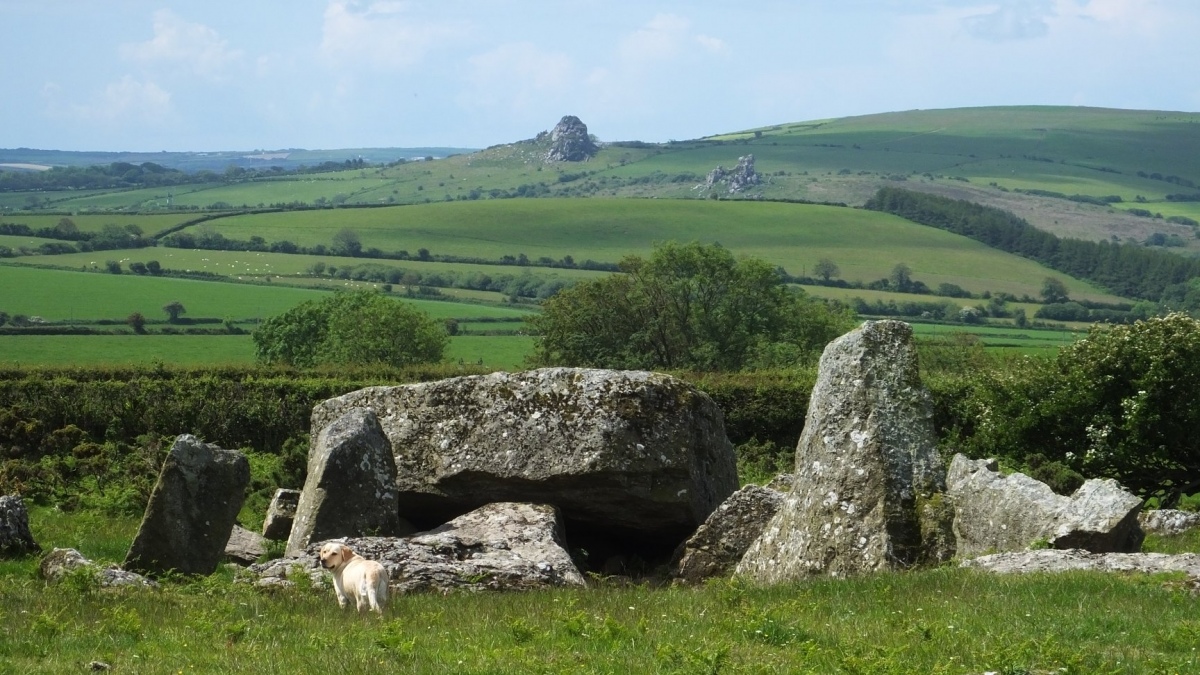
You may be viewing yesterday's version of this page. To see the most up to date information please register for a free account.





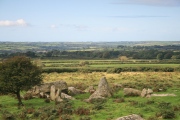
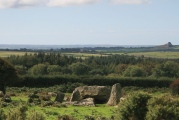

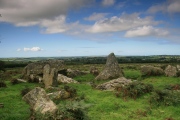
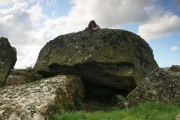

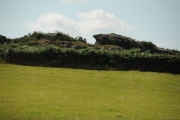
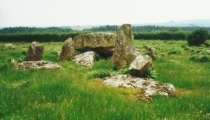



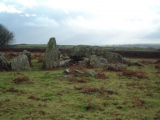


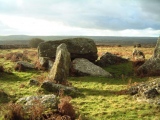




These are just the first 25 photos of Garn Turne. If you log in with a free user account you will be able to see our entire collection.
Do not use the above information on other web sites or publications without permission of the contributor.
Click here to see more info for this site
Nearby sites
Key: Red: member's photo, Blue: 3rd party photo, Yellow: other image, Green: no photo - please go there and take one, Grey: site destroyed
Download sites to:
KML (Google Earth)
GPX (GPS waypoints)
CSV (Garmin/Navman)
CSV (Excel)
To unlock full downloads you need to sign up as a Contributory Member. Otherwise downloads are limited to 50 sites.
Turn off the page maps and other distractions
Nearby sites listing. In the following links * = Image available
728m SSE 153° Parc Y Llyn* Burial Chamber or Dolmen (SM98232659)
941m NNE 20° The Altar* Chambered Tomb (SM98282812)
1.3km NW 304° Hogtivis Stone* Early Christian Sculptured Stone (SM969280)
2.7km W 276° Lower Broadmoor* Standing Stone (Menhir) (SM95212765)
4.2km E 88° Henne Barrow Round Barrow(s) (SN021272)
4.3km NE 42° Puncheston Stone* Standing Stone (Menhir) (SN009303)
4.4km S 181° Spittal Church Early Christian Sculptured Stone (SM977229)
4.5km NE 34° Parc Lan Cairn Cairn (SN006309)
4.7km W 273° St Lawrence Camp Promontory Fort / Cliff Castle (SM93212771)
4.7km WNW 295° Letterston III Stone Circle (SM937294)
4.8km ENE 65° Carn Fuwch Ancient Village or Settlement (SN024291)
5.0km NNE 29° Fagwyr Fran* Multiple Stone Rows / Avenue (SN005315)
5.4km ENE 62° Mynydd Castlebythe Cairn (SN028296)
5.6km WNW 283° Ty-newydd-grug* Standing Stone (Menhir) (SM9247228708)
5.8km W 278° BrynGwyn Stone Standing Stone (Menhir) (SM9223728297)
5.9km NNE 28° Mynydd Cilciffeth Cairn (SN009324)
6.2km WSW 250° Barnards Hill Tumulus Round Barrow(s) (SM91962536)
6.3km ENE 78° Tufton Castle Ancient Village or Settlement (SN04172834)
6.5km E 86° Castell Hendre Ancient Village or Settlement (SN04472740)
6.8km NNW 327° Llanstinan Bridge* Ancient Trackway (SM944331)
6.9km ENE 78° Tavern Farm Ancient Village or Settlement (SN04792842)
7.2km NE 54° Mynydd Morvil Barrow Cemetery (SN039313)
7.3km ESE 110° Parc-y-marl Misc. Earthwork (SN047245)
7.3km NE 49° Morvil church* Early Christian Sculptured Stone (SN037318)
7.4km N 8° Llanychaer Church* Early Christian Sculptured Stone (SM992345)
View more nearby sites and additional images



 We would like to know more about this location. Please feel free to add a brief description and any relevant information in your own language.
We would like to know more about this location. Please feel free to add a brief description and any relevant information in your own language. Wir möchten mehr über diese Stätte erfahren. Bitte zögern Sie nicht, eine kurze Beschreibung und relevante Informationen in Deutsch hinzuzufügen.
Wir möchten mehr über diese Stätte erfahren. Bitte zögern Sie nicht, eine kurze Beschreibung und relevante Informationen in Deutsch hinzuzufügen. Nous aimerions en savoir encore un peu sur les lieux. S'il vous plaît n'hesitez pas à ajouter une courte description et tous les renseignements pertinents dans votre propre langue.
Nous aimerions en savoir encore un peu sur les lieux. S'il vous plaît n'hesitez pas à ajouter une courte description et tous les renseignements pertinents dans votre propre langue. Quisieramos informarnos un poco más de las lugares. No dude en añadir una breve descripción y otros datos relevantes en su propio idioma.
Quisieramos informarnos un poco más de las lugares. No dude en añadir una breve descripción y otros datos relevantes en su propio idioma.